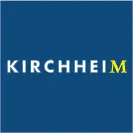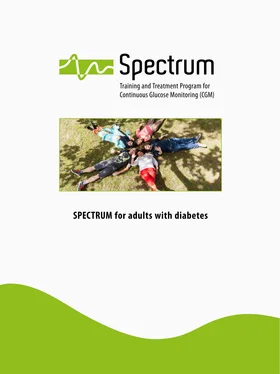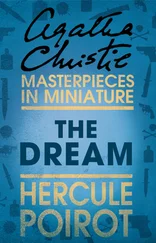The training and treatment program SPECTRUM is a product neutral, manufacturer-independent program which is used to train patients with diabetes in all age groups who wish to begin using realtime continuous glucose monitoring.
SPECTRUM is a cooperation project of the AGDT (Diabetes & Technology Working Group of the German Diabetes Association) and the AGPD (Pediatric Diabetology Working Group of the German Diabetes Association). The SPECTRUM working group of the AGDT developed a set of slides for adult patients with diabetes. Using this, the SPECTRUM working group of the AGPD developed a set of slides to train teenagers and parents of younger children with diabetes. Both working groups also put the necessary curricula together.
The creation of SPECTRUM was done on a voluntary and unsalaried basis. The AGDT covered the organizational costs for the SPECTRUM working group of the AGDT and the costs for the editorial completion of SPECTRUM by the research institute of the Diabetes-Akademie Mergentheim (Berthold Maier, FIDAM). The AGPD covered the organizational costs for the SPECTRUM working group of the AGPD and for the consultation services of an external graphic designer to a lesser extent. The Kirchheim Publishing House covered the costs for photography, layout and graphic design of the original German version.
Bernhard Gehr, Senior Diabetologist in Fachklinik Bad Heilbrunn (south of Munich, Germany), is the project leader of the entire SPECTRUM program and head of the adult version on behalf of the AGDT. Martin Holder, Chief Physician in the Stuttgart Clinic, Olgahospital, is head of the pediatric version on behalf of the AGPD.
The set of slides for adults was created under the leadership of Bernhard Gehr (head of Module 1) with the assistance of Bernd Kulzer (head of Module 0), Ulrike Thurm (head of Module 2), Thorsten Siegmund (head of Module 3), Claudia Sahm (head of Modules 4, 5 and 6) and additional support by Eberhard Biermann, Sabine Carstensen (until Feb/2014), Guido Freckmann, Lutz Heinemann, Elke Kerth, Ralf Kolassa, Andreas Liebl, Rosalie Lohr, Berthold Maier, Kerstin Remus, Sandra Schlüter, Marcella Schulz-Braun and Marita Wernsing. Berthold Maier was responsible for unifying and preparing the slide drafts. Mr. Maier was also responsible for preparing the curriculum of the adult version. Elke Kerth and Berthold Maier organized the photo shoot for the adult version.
The set of slides for teenagers and parents of children with diabetes was created under the leadership of Martin Holder and with the assistance of Simone von Sengbusch, Ralph Ziegler, Dorothee Deiss, Bettina Heidtmann, Carmen Ludwig-Seibold, Tanja Wadien, Kerstin Remus and Karin Lange. Karin Lange was responsible for preparing the curriculum of the pediatric version. Martin Holder and Tanja Wadien organized the pediatric photo shoot.
We sincerely thank all the CGM wearers who took part in the photo shoot.
Bibliographic Information of the Deutsche Bibliothek (German Library)The Deutsche Bibliothek lists the original German publication in the Deutschen Nationalbibliographie (German National Library); detailed bibliographic data can be called up on the Internet at http://dnb.ddb.de
ISBN ISBN 978-3-87409-713-0
Publisher

© Verlag Kirchheim + Co. GmbH, Kaiserstraße 41, 55116 Mainz
www.kirchheim-shop.de
2nd updated version 2017

Arbeitsgemeinschaft Diabetes und Technologie der Deutschen Diabetes-Gesellschaft
(Diabetes & Technology Working Group of the German Diabetes Association)

Arbeitsgemeinschaft pädiatrische Diabetologie der Deutschen Diabetes-Gesellschaft
(Pediatric Diabetology Working Group of the German Diabetes Association)
Bernhard Gehr, Martin Holder, Bernd Kulzer, Ulrike Thurm, Thorsten Siegmund, Claudia Sahm, Eberhard Biermann, Sabine Carstensen, Guido Freckmann, Lutz Heinemann, Ralf Kolassa, Elke Kerth, Andreas Liebl, Rosi Lohr, Berthold Maier, Kerstin Remus, Marcella Schulz-Braun, Sandra Schlüter, Marita Wernsing, Dorothee Deiss, Bettina Heidtmann, Carmen Ludwig-Seibold, Simone von Sengbusch, Tanja Wadien, Ralph Ziegler, Karin Lange.
SPECTRUM and all of its parts are protected by copyright. Any use outside of narrow bounds of the Copyright Law is not permitted and is punishable by law without consent of the publisher. This applies in particular to reproductions, translations, microfilming, storage and processing in electronic systems.
Photography: Victor S. Brigola, Stuttgart
Design: Dupont & Steyer, Windesheim
Reprinting or reproduction, copying of any kind, either in its entirety or in part, is only permitted with the written permission of the publisher.
Protected brand names (trademarks) are not specially indicated. The absence of such notes may not be interpreted to mean that a brand name is unregistered.
SPECTRUM and all of its parts are protected by copyright. Any use outside of narrow bounds of the Copyright Law is not permitted and is punishable by law without consent of the publisher. This applies in particular to reproductions, translations, microfilming, storage and processing in electronic systems.
© Verlag Kirchheim + Co. GmbH, Kaiserstraße 41, 55116 Mainz
All about SPECTRUM
The Authors
Dear Training Teams, dear Colleagues,
Dear Users,
1. Frequently asked questions on SPECTRUM (adult version)
2. Importance of SPECTRUM for successful CGM use
3. SPECTRUM: Modern didactics and methodology
4. How to use the curriculum
5. The authors of SPECTRUM (“The SPECTRONAUTS”)
Module 0: Introduction
0.1 Welcome and introduction
0.2 Short introduction round
0.3 What is CGM?
0.4 How does continuous glucose monitoring work?
0.5 What are the advantages and disadvantages
0.6 What CGM systems are available?
0.7 What does continuous glucose monitoring cost? Is cost reimbursement available?
0.8 Your questions and your decision
0.9 Good-bye
Module 1: Basics of contiuous glucose monitoring (CGM)
1.1 Welcome and introduction
1.2 How a CGM system works
1.3 Display of the CGM system
1.4 Accuracy of the CGM system
1.5 Calibration
1.6 Current glucose trend: interpreting correctly and taking action
1.7 Alarm functions
1.8 Tasks to be performed at home
1.9 What’s next in Module 2
Module 2: CGM Start
2.1 Overview of topics for Module 2
2.2 Basic settings, alarm settings, proven CGM initial settings in detail
2.3 Inserting the first sensor
2.4 What should CGM users observe when calibrating?
2.5 Tips for the first days
2.6 Exercises
2.7 What’s next in Module 3
Module 3: CGM display and alarms
3.1 Overview of topics for Module 3
3.2 The first days with the CGM system: Exchanging experience
3.3 Calibration and alarms
3.4 Correctly interpreting information on the CGM display
3.5 What’s next in Module 4
Module 4: Analyzing personal CGM data (Part 1)
4.1 Overview of topics for Module 4
4.2 In retrospect: the first weeks with the CGM system
Читать дальше















